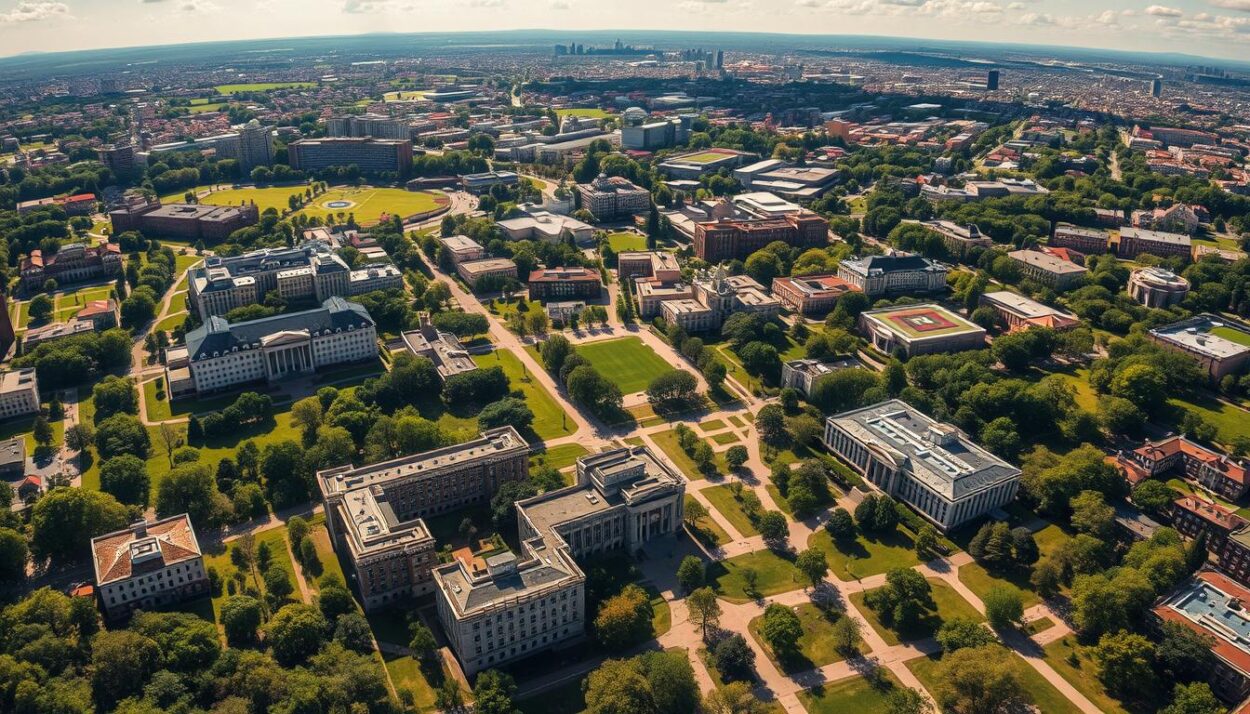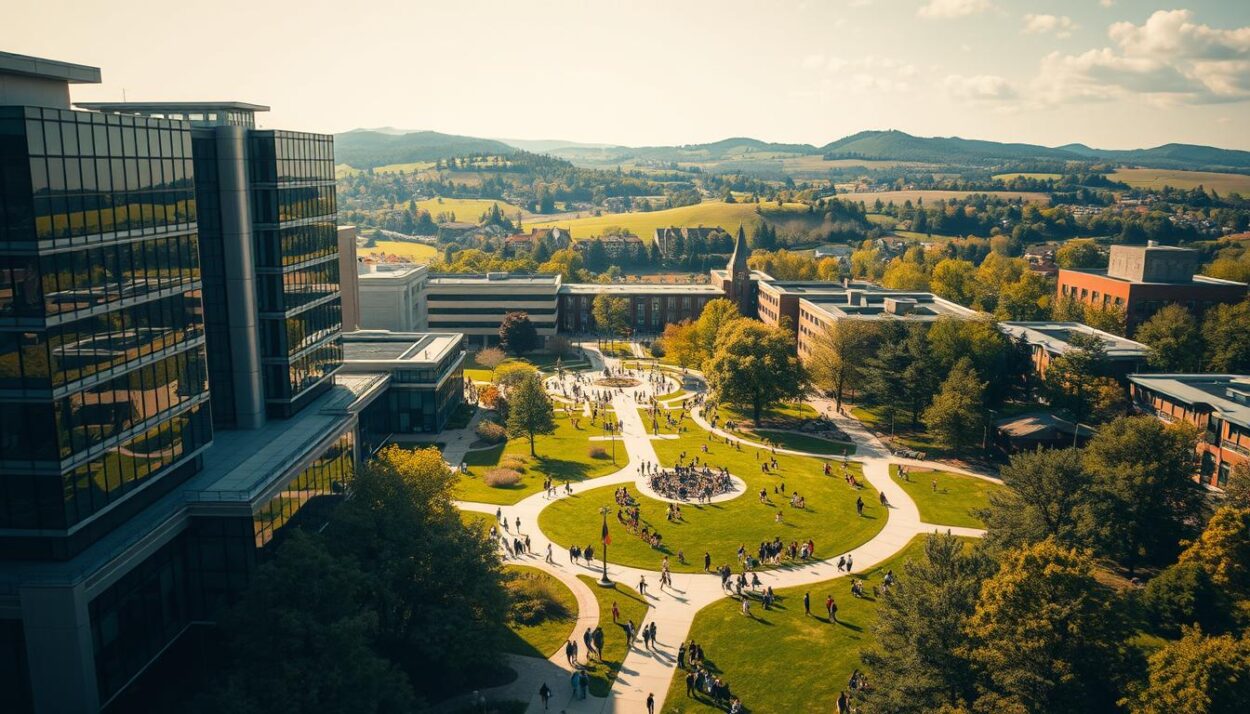Did you know that the largest university campus in the United States, Berry College, spans an impressive 27,000 acres? This staggering size is not just a testament to its expansive natural beauty but also emphasizes the profound impact of campus size on educational experiences across the nation. In the following sections, this article will explore the Top 12 Largest University Campuses in the US [Ranking of 2025] based on acreage and student enrollment, drawing insights from credible sources like LawnStarter and the National Center for Education Statistics (NCES). Understanding these largest US campuses goes beyond mere numbers; it highlights the significance of space in fostering vibrant academic communities.
Key Takeaways
- Berry College holds the title as the largest university campus in the US
- The ranking focuses on both acreage and student enrollment
- Campus size can influence the student experience and community engagement
- Research from credible sources ensures accuracy in rankings
- Understanding campus scale can guide prospective students in their choices
Introduction to Campus Size and Importance
Understanding campus sizes is crucial for prospective students and educators alike. The university size plays a significant role in shaping academic experiences. Various factors contribute to this notion, including the available facilities, resources, and opportunities for engagement on campus.
Understanding the Significance of Campus Area
The significance of campus area extends beyond mere square footage. Larger campuses often provide more physical spaces for recreation, study, and social interaction. These environments can lead to a vibrant student life, fostering connections among diverse populations. Research has shown that expansive campuses promote numerous activities and opportunities, enriching the overall university experience.
The Impact of Campus Size on Student Experience
Campus size significantly influences student experience. Larger universities typically host a more diverse student body, facilitating multicultural interactions. Such interactions enhance learning and encourage the exchange of ideas among students from various backgrounds. Additionally, the emotional and psychological benefits derived from well-maintained greenspaces contribute to a positive atmosphere, promoting mental well-being among students. Understanding the dynamics of campus sizes thus becomes essential for those navigating the higher education landscape.
Top 12 Largest University Campuses in the US [Ranking of 2025]
The 2025 university ranking for the largest campuses provides a fascinating insight into the educational landscape in the United States. This ranking underscores the expansive acreage of these institutions, contributing significantly to their academic missions and social environments. Criteria for ranking included total land area, student enrollment numbers, and facilities offered, helping establish a clear view of each campus’s scope and educational impact.
Overview of the Ranking Criteria
The criteria for ranking the largest campuses consists of various metrics that reflect their scale and resources. Total acreage plays a critical role, with institutions providing details on their land holdings through direct inquiries. Enrollment data from the U.S. Department of Education further complements this information. The final ranking not only highlights the size but also indicates how these top ranking universities utilize their space for academic and recreational purposes.
Notable Highlights of the Largest Campuses
Several campuses stand out for their sheer size and unique features. Berry College, for instance, boasts over 27,000 acres, making it a leader in the 2025 university ranking. Following closely is the SUNY College of Environmental Science and Forestry, which claims approximately 25,000 acres. These vast campuses not only serve their student bodies but also offer diverse ecosystems and recreational opportunities, setting a benchmark for other institutions.
Largest University Campuses Overview
The largest US campuses offer diverse environments conducive to academic and extracurricular activities. Understanding these institutions provides insights into the unique experiences they cultivate for their students. This overview highlights key features of such campuses, focusing on their size, educational resources, and distinct characteristics.
Berry College: The Largest Campus
Berry College holds the distinction of being the largest campus in the United States, encompassing an impressive 27,000 acres. The expansive natural landscape includes a wildlife sanctuary, which enhances the educational experience by providing opportunities for environmental studies and outdoor activities. This setting contributes to the university campuses overview, showcasing how natural surroundings can enrich learning.
SUNY College of Environmental Science and Forestry
SUNY College of Environmental Science and Forestry, located in Syracuse, New York, offers a focused academic environment on around 2,100 acres. This campus specializes in environmental sciences, attracting students interested in ecology and sustainability. The resources available on this campus exemplify the highlights of large campuses, featuring extensive laboratories and research areas dedicated to environmental studies.
United States Military Academy
The United States Military Academy at West Point is renowned for its rigorous academic programs and a strong emphasis on leadership training. Occupying approximately 16,000 acres along the Hudson River, this campus fosters a unique blend of military and academic discipline. The comprehensive educational offerings reflect the diverse learning environments found within large campuses across the nation.
Additional Significant Campuses
- Texas A&M University features over 5,200 acres, known for its vibrant student life and extensive research initiatives.
- University of California, Davis occupies nearly 5,300 acres, with a reputation for agricultural sciences and sustainability.
- University of Florida boasts around 2,000 acres with a wide range of academic programs and recreational facilities for students.

Factors Influencing Campus Size
The physical attributes of university campuses are shaped by various critical factors influencing campus size. These elements include enrollment numbers, land area, and the accompanying financial resources that institutions can allocate to expand their educational offerings. Understanding these factors provides insights into how universities can grow to accommodate student demands while ensuring the availability of essential educational resources.
Enrollment vs. Land Area
Enrollment figures significantly impact campus design and land usage. While high enrollment often suggests a need for expansive facilities, this does not always manifest in larger land areas. Some universities successfully manage substantial enrollments within a limited footprint, utilizing vertical building designs and efficient use of existing resources. This approach allows for maximizing social interaction and academic engagement despite constraints in land area.
The Role of Funding and Resources
University funding plays a pivotal role in determining the extent to which campuses can develop facilities. Financial resources allow for upgrades and expansions that enhance educational resources, catering to student needs comprehensively. Institutions often balance between land use and budgeting priorities, ensuring they can offer diverse academic programs and necessary amenities. The integration of personalized learning spaces and modern technology into course offerings remains contingent on both available funding and strategic planning.

Impact of Large Campuses on Communities
Large university campuses wield significant influence on their surrounding communities, driving both economic and cultural dynamics. The presence of these institutions fosters a vibrant atmosphere that can lead to notable improvements in local quality of life. Their economic contributions encompass diverse areas such as job creation, local spending by students and faculty, and investments that bolster the community structure.
Economic Contributions of Large Universities
Universities serve as critical economic engines within their locales. Tuition fees contribute to funding not only internal operations but also local businesses that cater to the needs of students and staff. The economic contributions of large universities significantly enhance region-specific job markets through various avenues:
- Direct employment opportunities for faculty and administrative staff.
- Indirect job creation through local vendors and service providers that support campus operations.
- Increased economic activity generated by student spending in housing, dining, and entertainment.
Cultural Influences within Academic Communities
Beyond economic contributions, large university campuses act as cultural hubs. They often host exhibitions, performances, and academic collaborations that engage the broader community. Such cultural influences not only enrich the academic experience but also foster deeper connections among residents. Key aspects include:
- Public access to cultural events and educational programs that stimulate community involvement.
- Facilitation of dialogue and exchange through collaborative projects with local artists and organizations.
- Creation of spaces that promote cultural diversity and inclusiveness within the campus and the surrounding area.
Conclusion
In examining the ranking of university campuses, it becomes clear that campus size plays a pivotal role in shaping student experiences and community impacts. Larger campuses, such as Berry College and those within the SUNY system, offer extensive resources and foster diverse populations, making them attractive options for many students. These institutions exemplify how ample physical space can enhance educational opportunities and support wide-ranging activities that significantly contribute to personal and academic growth.
However, the significance of campus size is not solely about its physical attributes. Individual preferences greatly influence students’ decisions, as some may prioritize smaller, more intimate environments over expansive properties. The conclusion on campus sizes suggests that while large universities enjoy advantages, the ideal educational landscape is highly subjective and varies among students.
As the landscape of higher education continues to evolve, ongoing analysis of university rankings and campus developments will remain essential. Stakeholders, including students and educators, must remain attentive to these dynamics, reflecting the continuous shifts in academic environments and the broader implications for society at large. Ultimately, the intersection of campus size, educational quality, and community involvement paints a comprehensive picture of the ever-changing nature of the U.S. higher education system.

![Top 12 Largest University Campuses in the US [Ranking of 2025]](https://www.southwestjournal.com/wp-content/uploads/2025/05/Top-12-Largest-University-Campuses-in-the-US-Ranking-of-2025.jpeg)











